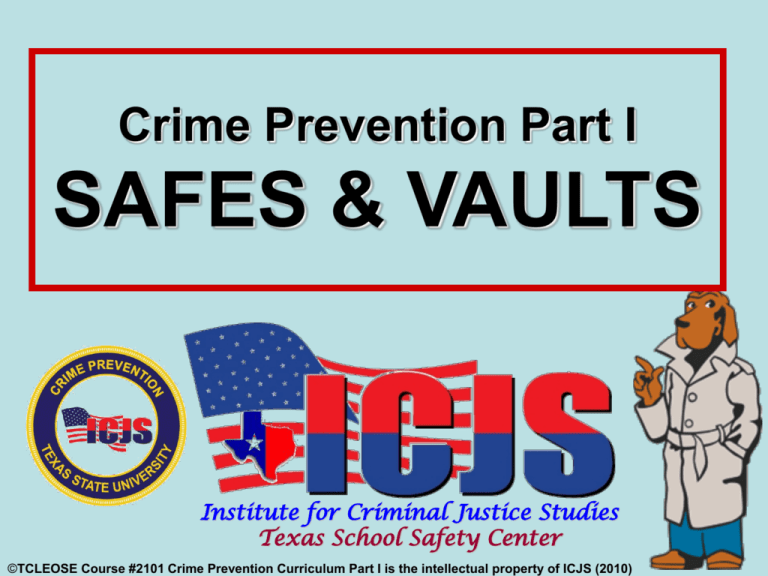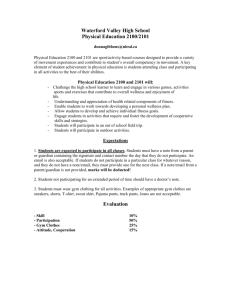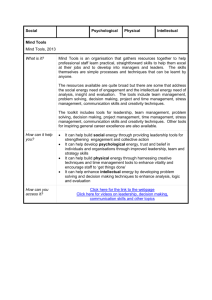Crime Prevention Part I Safes 2009 (Rev 03-09)
advertisement

Crime Prevention Part I SAFES & VAULTS Institutefor for Criminal Criminal Justice Studies Institute Justice Studies Texas School Safety Center ©TCLEOSE Course #2101 Crime Prevention Curriculum Part I is the intellectual property of ICJS (2010) LEARNING OBJECTIVES • Learning Objective: The student will be able to identify the different types of safes and vaults. • Learning Objective: The student will be able to identify and explain the proper use of a money and fire safe. • Learning Objective: The student will be able to identify and explain the various classes of insulated record containers. • Learning Objective: The student will be able to identify and explain the different type of safe locks. • Learning Objective: The student will be able to identify and explain the various UL classifications of money and fire safes. • Learning Objective: The student will be able to identify and explain the following areas that affect the security of safes and vaults; location and installation, protecting the combination and usage in compliance with classification. ©TCLEOSE Course #2101 Crime Prevention Curriculum Part I is the intellectual property of ICJS (2009) SAFES & VAULTS A SAFE or VAULT ideally should occupy the innermost ring of concentric protective rings around a secured premise.. We are referring to the third line of defense the interior of a building ©TCLEOSE Course #2101 Crime Prevention Curriculum Part I is the intellectual property of ICJS (2009) SAFES - General Safe makers cannot make safe bodies as thick as they would like Too big to pass through doorways Too heavy to stand on floor of ordinary buildings Safes made at a cost which the customer will accept. ©TCLEOSE Course #2101 Crime Prevention Curriculum Part I is the intellectual property of ICJS (2009) Introduction to SAFES There are two types of safes. Each is intended for a different purpose. The first type, generally known as a fire safe, is designed to protect records from destruction by fire. ©TCLEOSE Course #2101 Crime Prevention Curriculum Part I is the intellectual property of ICJS (2009) Introduction to SAFES The second type, commonly known as a money safe or money chest, is designed to protect money and valuables from burglary or theft. ©TCLEOSE Course #2101 Crime Prevention Curriculum Part I is the intellectual property of ICJS (2009) SAFES - Confusion Confusion exists over the use of these two safes. Many users believe they have more protection than they actually do and unknowingly submit their valuables to risk. Because of this common misunderstanding, it is important that know to use a safe for the purpose for which it is designed. ©TCLEOSE Course #2101 Crime Prevention Curriculum Part I is the intellectual property of ICJS (2009) FIRE SAFE Fire safe, “commercial records safe”, fire resistant qualities. provides only minimal protection from burglary and theft. fire safe constructed of light steel manufacturer more concerned with insulation of the safe against fire vs. burglary defense FIRE SAFE – Cont’d Fire resistant safes normally made with hollow walls of relatively thin steel, filled with varying amounts of insulation. easily broken open with a burglar’s heavy tool or with a firefighter’s ax. do not store valuables that are easily converted to cash or cash ©TCLEOSE Course #2101 Crime Prevention Curriculum Part I is the intellectual property of ICJS (2009) FIRE SAFE – Cont’d Store important papers only in a fire safe: tax records – CD or DVD booking logs - ledgers insurance polices ©TCLEOSE Course #2101 Crime Prevention Curriculum Part I is the intellectual property of ICJS (2009) FIRE SAFES ©TCLEOSE Course #2101 Crime Prevention Curriculum Part I is the intellectual property of ICJS (2009) FIRE SAFE – Cont’d The type & amount of insulation used in a fire safe determines the degree of protection afforded its contents. Example, paper products destroy when exposed to temperatures in excess of 350° F. Designed to keep interiors below critical 350° F level. ©TCLEOSE Course #2101 Crime Prevention Curriculum Part I is the intellectual property of ICJS (2009) FIRE SAFE (PURPOSE) The purpose of the fire safe is to ensure that after a fire its contents are “useable.” ©TCLEOSE Course #2101 Crime Prevention Curriculum Part I is the intellectual property of ICJS (2009) FIRE SAFE (PURPOSE) The concept of “useable” documents is important. A document is considered usable only if “…after a fire it can withstand ordinary handling without breaking and if marks on the paper can be deciphered by ordinary means” ©TCLEOSE Course #2101 Crime Prevention Curriculum Part I is the intellectual property of ICJS (2009) ©TCLEOSE Course #2101 Crime Prevention Curriculum Part I is the intellectual property of ICJS (2009) Underwriters Laboratories 1. A standardized fire of controlled extent and severity for: at least four hours (reaching 2000° F) two hours (reaching 1850°F), or ©TCLEOSE Course #2101 Crime Prevention Curriculum Part I is the intellectual property of ICJS (2009) Underwriters Laboratories one hour (reaching 1700°F) depending upon its hourly rating, before the interior temperature of the compartment exceeds the rated class temperature (350°F,150°F,or l25°F) during the period of fire exposure and the cooling period inside the furnace after the fire exposure. ©TCLEOSE Course #2101 Crime Prevention Curriculum Part I is the intellectual property of ICJS (2009) Underwriters Laboratories 2. A sudden heating at 2000°F for 30 minutes without producing an explosion sufficient to cause an opening into the interior. Underwriters Laboratories 3. An impact due to falling 30 feet in the clear after being heated for 60 minutes, 45 minutes, or 30 minutes for devices rated 4, 2, and 1 hour, respectively; ©TCLEOSE Course #2101 Crime Prevention Curriculum Part I is the intellectual property of ICJS (2009) Underwriters Laboratories 3. and reheating in the inverted position for the same length of time (60minutes, 45 minutes, or 30 minutes) after the impact without destroying the usability of the papers stored inside. ©TCLEOSE Course #2101 Crime Prevention Curriculum Part I is the intellectual property of ICJS (2009) FIRE SAFE (Design) Another important fire safe characteristic is its “re-usability.” Second-hand” fire safe does not provide good fire protection. fire safes often make use of inflating materials that consist of gypsum, plaster, or other hydrous compounds. When exposed to fire, this inflating material is converted to steam which cuts down the destructive qualities of the fire ©TCLEOSE Course #2101 Crime Prevention Curriculum Part I is the intellectual property of ICJS (2009) Combustion Material Paper may be destroyed if exposed to temperatures above 350°F. Films and videos are heat-sensitive and may be destroyed if exposed to temperatures above 150°F. Computer disks are the most sensitive to heat and may be destroyed if exposed to temperatures above 125°F. ©TCLEOSE Course #2101 Crime Prevention Curriculum Part I is the intellectual property of ICJS (2009) ©TCLEOSE Course #2101 Crime Prevention Curriculum Part I is the intellectual property of ICJS (2009) Class 350 FIRE SAFE PROTECT: DISKS MICRO FILM (microfiche) FILM ROLLS VIDEO ©TCLEOSE Course #2101 Crime Prevention Curriculum Part I is the intellectual property of ICJS (2009) Look for Classification Marking on Product Insulated Record Containers Class 125 Classified by: Underwriter Laboratories, Inc. As to Fire Resistance Only Rating: Class 125-2 ©TCLEOSE Course #2101 Crime Prevention Curriculum Part I is the intellectual property of ICJS (2009) MONEY SAFE The key feature of money safe is its resistance to burglary or robbery. Burglary restrictive safes are designed to withstand attacks by tools, torch, or explosives in proportion to their construction specifications. ©TCLEOSE Course #2101 Crime Prevention Curriculum Part I is the intellectual property of ICJS (2009) MONEY SAFE On the other hand, robbery restrictive equipment is designed to prevent thefts when there is no assault on the money safe itself. ©TCLEOSE Course #2101 Crime Prevention Curriculum Part I is the intellectual property of ICJS (2009) MONEY SAFES ©TCLEOSE Course #2101 Crime Prevention Curriculum Part I is the intellectual property of ICJS (2009) MONEY SAFE - continued Money safes with key locks, lockers, and truck boxes with either key or combination locks fit this category. Safes of this type are usually of a lighter construction with less costly locking equipment ©TCLEOSE Course #2101 Crime Prevention Curriculum Part I is the intellectual property of ICJS (2009) MONEY SAFE - continued Most safes today have undergone stringent testing at the Underwriters Laboratories, Inc. in Northbrook, Illinois. The Underwriters Laboratories, Inc. label applied to these units indicates a classification of the units, and to an extent, its capabilities. ©TCLEOSE Course #2101 Crime Prevention Curriculum Part I is the intellectual property of ICJS (2009) MONEY SAFE - continued Supermarkets, gas stations, mill outlets, automobile sales agencies, theaters, motels, and restaurants are among the businesses now using round door chests. Any firm doing volume cash business requires this type of protection against hold-ups and burglary. The reason for the big shift to round door chests is insurance savings. ©TCLEOSE Course #2101 Crime Prevention Curriculum Part I is the intellectual property of ICJS (2009) MONEY SAFE - continued The better the safe, the lower the risk and the lower rate of insurance. Insurance companies know the value of proper cash protection and they offer large insurance premium savings to people who use round chests. ©TCLEOSE Course #2101 Crime Prevention Curriculum Part I is the intellectual property of ICJS (2009) ©TCLEOSE Course #2101 Crime Prevention Curriculum Part I is the intellectual property of ICJS (2009) BURGLAR RESISTENT Key feature resist burglary and robbery It can only provide protection against the tools and techniques known at the time of construction ©TCLEOSE Course #2101 Crime Prevention Curriculum Part I is the intellectual property of ICJS (2009) BURGLAR RESISTENT Burglary restrictive safes designed to withstand attacks by: Tools Torch Explosives ALL in proportion to their construction specifications. ©TCLEOSE Course #2101 Crime Prevention Curriculum Part I is the intellectual property of ICJS (2009) Gary FS-FSM Safe Square door safe. Designed to meet the cash handling protection needed for supermarkets and chain stores. Four Sections 14 cash register trays Manager depository locker Armored car collector’s compartment with dual key protection Rolled coin container on the safe door. Provides ideal burglary and holdup protection ©TCLEOSE Course #2101 Crime Prevention Curriculum Part I is the intellectual property of ICJS (2009) ©TCLEOSE Course #2101 Crime Prevention Curriculum Part I is the intellectual property of ICJS (2009) Gary FS-FSM Safe Design One-inch carbon steel and all the joints are electrically welded. Door is one and one-half inches thick carbon steel with extra heavy hinges with ball bearings assuring a proper door swing. Three one-inch chrome-plated bolts and a continuous locking bar on the hinge side lock this door. The safe has special “Max alloy” drill resistive hard plate to protect lock and bolt workings. ©TCLEOSE Course #2101 Crime Prevention Curriculum Part I is the intellectual property of ICJS (2009) SAFE “DROP BOX” ©TCLEOSE Course #2101 Crime Prevention Curriculum Part I is the intellectual property of CSCS-ICJS (2009) SAFE LOCKS Locking dials Lockable handles Time Locks Time-delay combination Alarm combination ©TCLEOSE Course #2101 Crime Prevention Curriculum Part I is the intellectual property of ICJS (2009) SAFE LOCKS – Cont’d LOCKING HANDLES: Lockable bolt control handles perform much the same function as lockable dials. A locking handle allows the combination to be dialed, but the bolt control handle does not retract the door bolts until it is unlocked. ©TCLEOSE Course #2101 Crime Prevention Curriculum Part I is the intellectual property of ICJS (2009) SAFE LOCKS – Cont’d TIME LOCKS: Standard equipment on bank vault doors. A time lock ensures that once closed and locked the safe or vault door remains so for a predetermined amount of time. ©TCLEOSE Course #2101 Crime Prevention Curriculum Part I is the intellectual property of ICJS (2009) SAFE LOCKS – Cont’d TIME – DELAY LOCKS: DAT or delayed action timer. A time-delay lock is a combination lock with one or more timer movements attached. The operator must wait for a predetermined period after dialing before delay mechanism permits the combination bolt to retract. ©TCLEOSE Course #2101 Crime Prevention Curriculum Part I is the intellectual property of ICJS (2009) SAFE LOCKS – Cont’d ALARMED COMBINATION LOCKS: Incorporate microswitches capable of shunting alarms and signalizing unauthorized opening attempts or openings made under duress. The dial is set at a predetermined number and sometimes locked in place, alarm is then turned on. ©TCLEOSE Course #2101 Crime Prevention Curriculum Part I is the intellectual property of ICJS (2009) TIME DELAY SAFES SAFE VULNERABILITIES Drills — diamond core. Torches — EXPLOSIVES acetylene burning bar or thematic lance—hollow iron pipe packed with steel rods — 4000F — 6” of tempered steel, 15 sec Keri coil — miniature version of burning bar—underwater cutting BURGLAR TOOLS For SAFES ©TCLEOSE Course #2101 Crime Prevention Curriculum Part I is the intellectual property of ICJS (2009) SECURITY RECOMMENDATIONS Precautions - Reminders Must be extremely hard component to blunt drills and heat absorbent component to combat thermal cutter Concrete—often strengthened by granite chips or by chilled iron shot which can spin or deny the drill ©TCLEOSE Course #2101 Crime Prevention Curriculum Part I is the intellectual property of ICJS (2009) SECURITY RECOMMENDATIONS Precautions - Reminders All top quality safes combat the drill with nuggets of a material almost as hard a diamond, closely packed with no clear path through them cutter SAFES should be fixed (nonmoveable) either encased in concrete or bolted to a solid foundation and/or frame ©TCLEOSE Course #2101 Crime Prevention Curriculum Part I is the intellectual property of ICJS (2009) SECURITY RECOMMENDATIONS Precautions - Reminders Foiling the cutters Best defense are metals that absorb the heat at the point of attack and dissipate it over a wide area Steels with high chromium or carbon content, notably stainless steel, and even cast iron Copper, second most effective ©TCLEOSE Course #2101 Crime Prevention Curriculum Part I is the intellectual property of ICJS (2009) SECURITY RECOMMENDATIONS Precautions - Reminders Lock attack Best defense are live devices backed up by dead devices which also secure the bolt frame but operate only if the lock is attacked Dead devices are bolts held back by cables running to the lock case and operate only if the cable connection is broken SECURITY RECOMMENDATIONS Precautions - Reminders Lock attack - Continued In high quality safes the cables are connected to a glass plate which disintegrates if punctured ©TCLEOSE Course #2101 Crime Prevention Curriculum Part I is the intellectual property of ICJS (2009) SAFE SECURITY CONCERNS SAFE COMBINATIONS Another important element in safe security is protecting the combinations. Protection of the combination is frequently overlooked Burglars found the combination written and left inside the desk of a nearby secretary or executive ©TCLEOSE Course #2101 Crime Prevention Curriculum Part I is the intellectual property of ICJS (2009) SAFE SECURITY CONCERNS SAFE COMBINATIONS – Cont’d Combination should always be memorized where possible Emergency copy of the combination available in some locked area where it cannot be discovered by a dishonest employee ©TCLEOSE Course #2101 Crime Prevention Curriculum Part I is the intellectual property of ICJS (2009) Safe: Security Checklist Secure lightweight safes to prevent removal Keep cash on hand at a minimum by frequently banking Never leave combination where it can be compromised ©TCLEOSE Course #2101 Crime Prevention Curriculum Part I is the intellectual property of ICJS (2009) Safe: Security Checklist Locate the safe in a secure area, and check to determine that the safe is proper for what is protects Lock the safe securely when leaving the premises by turning the dial several times in the same direction ©TCLEOSE Course #2101 Crime Prevention Curriculum Part I is the intellectual property of ICJS (2009) VAULTS BANKS Safety deposit boxes Money JEWERLY STORES MUSEUMS SOME High end very expensive homes. ©TCLEOSE Course #2101 Crime Prevention Curriculum Part I is the intellectual property of ICJS (2009) VAULTS BANK VAULT JEWERLY MUSEUM CHARLTON VAULT VAULT HESTON HOME VAULT ©TCLEOSE Course #2101 Crime Prevention Curriculum Part I is the intellectual property of CSCS-ICJS (2009) KNOW YOUR DIFFERENT SAFES and there Capabilities ©TCLEOSE Course #2101 Crime Prevention Curriculum Part I is the intellectual property of ICJS (2009) ©TCLEOSE Course #2101 Crime Prevention Curriculum Part the intellectual property CSCS-ICJS (2009) ©TCLEOSE Course #2101 Crime Prevention Curriculum Part II is the intellectual property of CSCS-ICJS ©TCLEOSE Course #2101 Crime Prevention Curriculum Part isI is the intellectual property ofof CSCS-ICJS CJS (2009) (2009) (2009) Remember A safe can provide adequate protection only when it is used for its intended purpose. ©TCLEOSE Course #2101 Crime Prevention Curriculum Part I is the intellectual property of ICJS (2009) DEFINE & PROCESS 1. Identify the different types of safes and vaults. 2. Identify and explain the proper use of a money and fire safe. 3. Identify and explain the various classes of insulated record containers. 4. Identify and explain the different type of safe locks. 5. Identify and explain the various UL classifications of money and fire safes. 6. Identify and explain the following areas that affect the security of safes and vaults; location and installation, protecting the combination and usage in compliance with classification. ©TCLEOSE Course #2101 Crime Prevention Curriculum Part I is the intellectual property of ICJS (2009) SOURCES Fennelly, Lawrence J. Handbook of Loss Prevention and Crime Prevention. Newton, MA., Butterworth-Heinemann, 251. Healy, Richard J. Design for Security. New York: John Wiley and Sons, Inc., 176-178, 189-190, 194-199. Hemphill, Charles F. Jr. Security for Businesses and Industry. Homewood, Illinois: Dow Jones-Irwin, Inc., 181,-194, 219-221. Information Material by “AMSEC”. Paramount, California: American Security Products Company. Information Material by “Gary”. Industry, California: Gary Safe Company. Underwriters Laboratories, Inc. Building Materials Directory. 301-304. ©TCLEOSE Course #2101 Crime Prevention Curriculum Part I is the intellectual property of ICJS (2009) Contact Information INSTITUTE for CRIMINAL JUSTICE STUDIES 350 N. Guadalupe, Suite 140, PMB 164 San Marcos, Texas 78666. 512-245-6232 www.criminaljusticestudies.com ©TCLEOSE Course #2101 Crime Prevention Part I Curriculum is the intellectual property of ICJS (2009) LUNCH TIME Take 55-Minutes And girls







